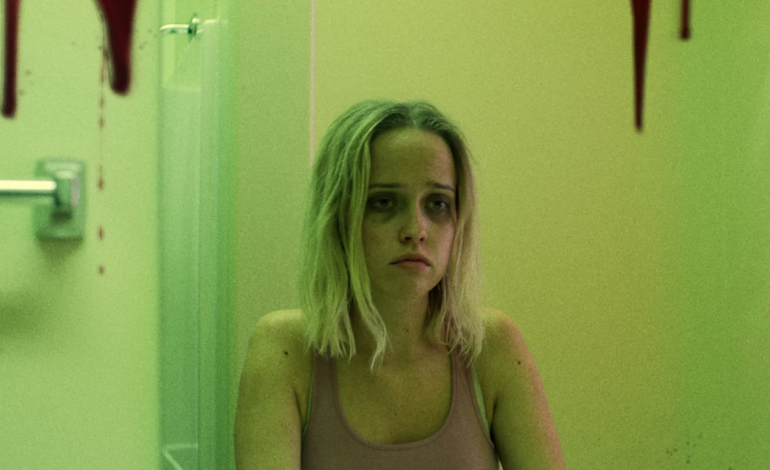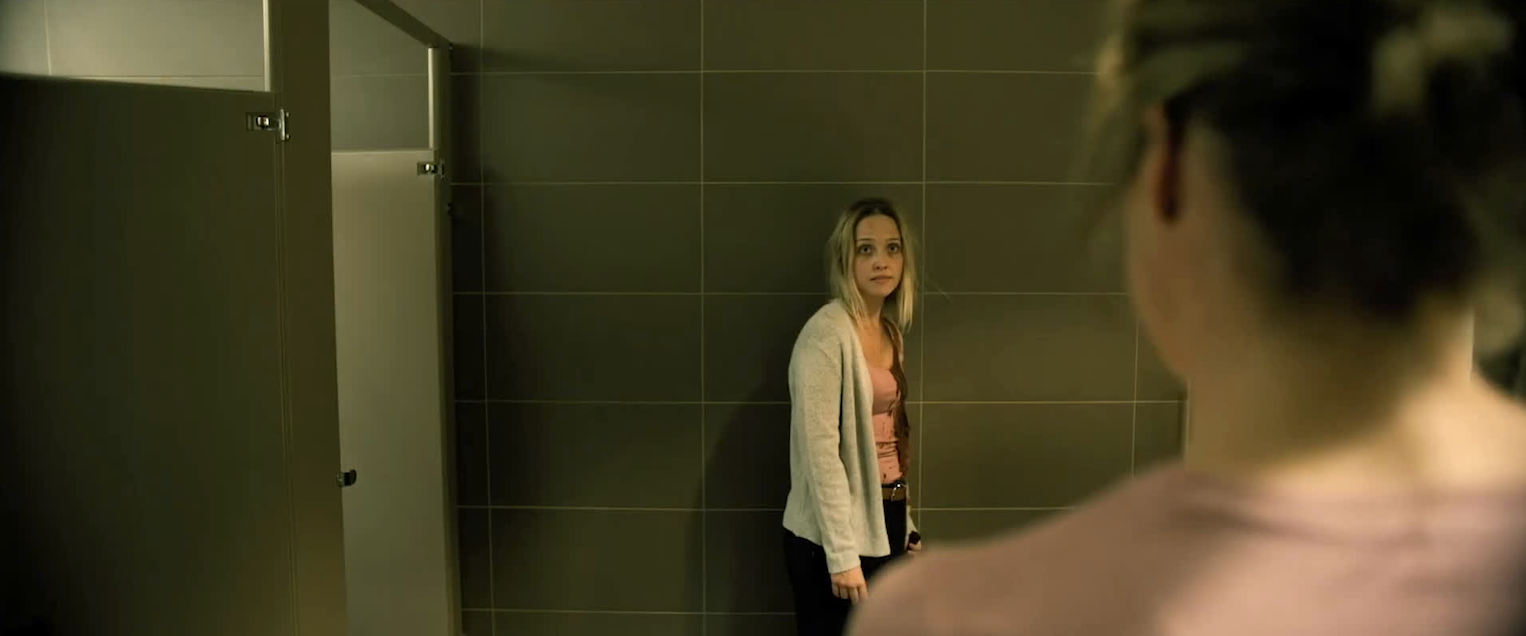

Directed by Robert Cuffley (Turning Paige, Ferocious, and Chokeslam) and written by Susie Moloney (“Planet Echo,” “Blackstone,” Suburbanight), Bright Hill Road (2020) follows alcoholic Marcy (Siobhan Williams) who is put on leave after a misstep at her job leads to a workplace shooting. Following the incident, she heads out to see her sister in California. Halfway there, she stops for a couple of days at the Bright Hill Road Boarding House, managed by the eerie and mysterious Mrs. Inman (Agam Darshi). The walls close in on the deeply troubled Marcy as she loses touch with reality and comes face to face with the misdeeds of her sordid past.
Despite being marketed and presented as a horror film, I unfortunately didn’t find Bright Hill Road all that scary. The most effective scene was the workplace shooting at the beginning, likely because it was the most grounded and visceral. You see this one shot of Marcy hiding in the bathroom stall with her feet on the toilet. It was very claustrophobic and effective. When Marcy arrives in Bright Hill Road, however, it’s mostly downhill from there. The film relies a lot on very cliched scares, such as hearing voices or things appearing in odd places. There were also a lot of obnoxious and loud jumpscares, a few of which were effective, but for the most part it would just be a shape that would appear accompanied by a loud noise. There were also a few instances in which a rotting corpse would appear, and maybe it was bad makeup or bad cgi, but I couldn’t take it at all seriously.


That’s not to say there weren’t effective moments. The film worked a lot better when the horror crept in and was subtle. For instance there was this one moment where it looked like a man was obscured in the corner of a frame, and a couple times when blood would slowly drip from the ceiling or out of the walls. Quieter moments like that were more effective. I also think the film, through the editing and direction, did a great job of portraying Marcy’s withdrawal. Though there is something else going on, you really get into her body and feel how sick and nauseous she is, and it makes for an intentionally frustrating experience in which you really feel how stuck and claustrophobic she is at this hotel and you really feel how badly she wants to leave but physically can’t.
I think the script was also quite weak. What stood out first was Mrs. Inman’s dialogue. Though I thought Agam Darshi (“You Me Her,” “Dirk Gently’s Holistic Detective Agency,” “Sanctuary”) did a great job, her performance felt very bogged down by the dialogue she was given. It was either very expositional or purposefully ominous. But ominous in a way that didn’t feel like she was actually saying anything that meaningful or interesting. In fact, I think exposition was one of a few reasons why the ending didn’t really work so much for me. No spoilers, but the final reveal as to what Bright Hill Road is, was quite underwhelming. The ending didn’t really come out of nowhere or anything like that, the execution was just sloppy. Not only did they have to shove a lot of exposition and character growth into the last few minutes in order to explain what the movie was leading up to, but even then the ending still left a few elements and plot points muddled and unclear.


The film does admittedly have a lot of interesting ideas and an interesting premise: an alcoholic woman with a lot of baggage from her past, is trapped in this mysterious Bright Hill Road on her path to sobriety, all the while her past deeds come back to haunt her. If anything it shows some similarities to the classic horror film The Shining, which the film even pays a bit of homage to. Even still, the problem with this film compared to something like The Shining is that they choose to over explain or overuse the ideas. I think the most effective horror comes from the unknown, and to have all these threads – a crying woman, a creepy man, objects and messages appearing – over explained to have everything make sense in the end, mitigates the effectiveness of the horror or scares.
The saving graces of this film were the editing, cinematography and Siobhan Williams’ (“Sacred Lies,” “Black Box,” Welcome to Marwen) performance. Her performance felt very raw and she brought a lot of depth to the role that wasn’t as present in the writing. You could really feel how weak and sick she was while experiencing withdrawal and her increasing fear and depseration to get to California and to escape the horrors. I also wanted to mention Michael Eklund (The Call, Eadweard, “Wynonna Earp”) as Owen. I thought he was quite good in the film, unfortunately though his character was written so one-dimensionally that it was hard to find him intimidating. As mentioned before, I believe that the cinematography from Robert Riebdeau was absolutely gorgeous. The colors and shot composition really popped and helped elevate the direction and script. The editing from Bridget Durnford was also quite effective and contributed to a lot of the tension and pacing. Both these things especially came together when Marcy was dealing with her drinking or withdrawal. The camera would go in and out of focus as well as accentuate details around the room which I thought was an effective way in placing us in Marcy’s head.


Verdict: 2 out of 5 Stars
A great lead performance and outstanding editing and cinematography helped elevate what was unfortunately a weak script with few effective scares and an underwhelming conclusion. Where I feel the horror fall flat was through the over-explanation of all the things Bright Hill Road shows or tells us. It made for what could’ve been an extremely introspective horror story about a woman grappling with her alcoholism and past mistakes, into a cookie cutter horror film with an overly sappy ending. Started off with a lot of promise, and though not a terrible experience, left a lot to be desired.
